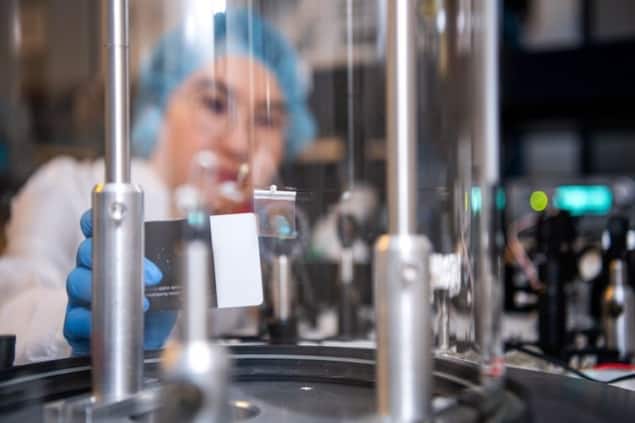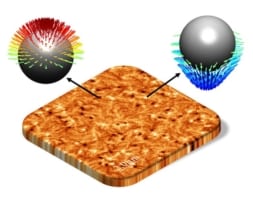
Like most spacecraft, the CHEOPS mission launched last week uses a chemical propellant to adjust its position once in orbit. The high mass of such propellants has, however, prompted space scientists to explore alternatives such as “light sails” that enable spacecraft to navigate using the radiation pressure from light, much as old-fashioned sailing ships used wind to travel the high seas. A team of researchers in the US has now taken a step towards a more powerful light sail by testing a prototype design that uses lasers and diffraction gratings rather than the sunlight and mirrors employed previously.
The simplest light sail designs, such as that adopted by JAXA’s IKAROS mission or the privately-funded LightSail 2, use a large, thin mirror to reflect sunlight. Although the propelling force from sails of this type is small compared to that supplied by chemical fuels, spacecraft that rely on sails do not have to carry their own fuel supply. Another advantage is that their “fuel” will never run out as long as the sail is illuminated – making them good candidates for future long-haul space missions that require more energy than chemical propellants can supply.
Staying aligned
A laser-based propulsion system could, in principle, retain many of these advantages while also providing a much greater acceleration. The trouble is that if the sail on such a spacecraft were to drift out of alignment with the central axis of the laser beam, the craft would lose power.
A team led by Grover Swartzlander at the Rochester Institute of Technology (RIT) has now developed a way around this problem. In the RIT system, the propulsion laser beam shines onto a pair of adjacent diffraction gratings. These paired gratings are arranged such that the left-hand grating deflects incident laser light slightly to the right, while the right-hand grating deflects it slightly to the left. The result is a force that propels the craft forward, plus a pair of opposing lateral forces that increase in magnitude the further the beam strays from the centre. Hence, when the bi-grating moves away from its equilibrium position, the lateral force pushes it back, allowing the sail to remain aligned.
Nanonewton-sized force re-centres the sail
This “beam rider” technology, as it has been dubbed, has passed a preliminary test in the laboratory with the demonstration of a centimetre-sized prototype. In this device, the micron-thin gratings are made from nematic liquid crystals fixed to a 100 micron-thick polymer film for structural support. The anisotropy axis of the crystals is rotated in the grating plane and arranged in a periodic pattern to produce the required deflection.

The researchers measured this deflection by placing the prototype in a sensitive force-measuring setup (known as a torsion oscillator in vacuum) and shining a laser beam onto its centre. Using time-lapse photography and force measurements, they observed that when the beam’s position shifts away from equilibrium, a nanonewton-sized force re-centres the device so that it returns to alignment with the beam.
Looking forward
The research, which is detailed in Physical Review Letters, is still in its infancy and there are many challenges to overcome. One key question is whether the technology can function in the vertical as well as the horizontal direction, and thereby control a spacecraft’s pitch as well as its side-to-side yaw. The RIT team plan to test their design in the coming months to find out.
Looking forward, Swartzlander says he hopes to use the team’s diffractive sails on a spacecraft that would fly a camera to the north and south poles of the Sun. “These sails are transparent, so they’re not going to absorb a lot of heat from the Sun, and we won’t have the heat management problem as you do with a (conventional, reflecting) metallic surface,” he says. He estimates that it would take five years for such a spacecraft to reach the solar poles and make the first direct images of these so-far-unobserved regions.

‘Oumuamua: visitor from another star
In the more distant future, Swartzlander believes that sail-driven spacecraft might occupy a prominent place in the developing space economy. “Convoys of reusable solar sails could be used to transport precious resources throughout the solar system without fuel, ferrying water and minerals to an orbiting processing facility,” he tells Physics World.
Philip Lubin of the University of California, Santa Barbara, who was not involved in the research, says that the RIT’s team’s work on diffractive reflectors for solar and laser sails is a “very important step forward”. In his view, the study, which was supported by NASA, shows that non-traditional custom materials such as diffractive and photonic crystal-based reflectors provide unique and highly desirable characteristics, including the ability to beam follow (for laser sails) and self-stabilize (for laser and solar sails). “Excellent work with much more to come,” he concludes.



